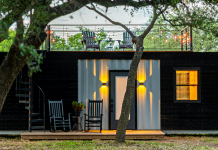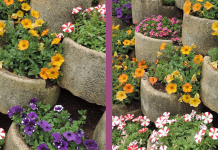Want to grow herbs and veggies but don’t have space? Why not mix them up with flowers in a sunny space close to your outdoor living area where they will be most appreciated and given the care they need.
There is no reason why veggies and flowers can’t grow together in your main garden. Salvias and spinach, Bidens and beetroot or poppies and lettuce are just some of the combo’s to consider.
Vegetables require almost daily attention and by mixing them up with your flowers, means that you don’t have to spread your attention to other parts of the garden.
Vegetable can be just as ornamental as flowers and shrubs. They have different coloured leaves, and textures, as well as flowers and fruit. The result can be a lush interplanting of flowers and veggies that will intrigue friends and family, especially if they are invited to harvest the salad or take home a bunch of Swiss chard.
Good companions
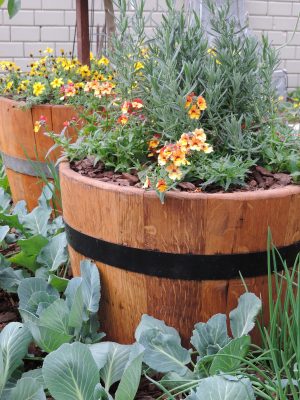
Growing veggies and flowers together is nothing new. Companion planting is an age old method that improves the productivity of vegetables. Flowers invite butterflies, birds and bees into the garden to pollinate squash, eggfruit and other veggies. They also attract beneficial insects that naturally control pests, which means no poisons are necessary.
Extending the practice of companion planting into our prime garden space, makes gardening more sustainable and productive.
Edible borders
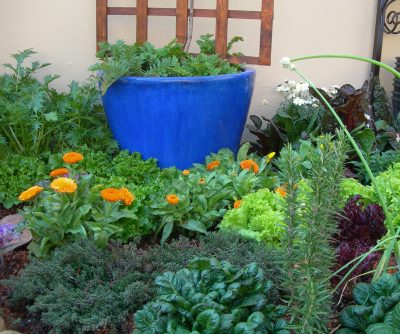
Loose leaf lettuce varieties offer a range of colours and leaf shapes (curly, oakleaf, lobed) that will make a colourful, textured border if planted close together. Harvest the individual leaves to maintain well shaped plants. The productive life is about 3 months. Plant in fertile, well composted soil in beds that receive morning sun or semi shade and water regularly. Don’t allow the plants to dry out. http://www.kirchhoffs.co.za/product/lettuce-mixed/
Herbs like parsley, garden mint in pots, thyme, golden and variegated oregano, chives, catmint, chervil, lemon balm, summer savory and cotton lavender (santolina) can be used as borders. In hotter, dryer beds, opt for thyme or silver-leaved sage. http://www.kirchhoffs.co.za/product-category/herbs/
What about a border of carrots with their lovely feathery tops?. Baby carrots can be planted closer together and are quicker to harvest. http://www.kirchhoffs.co.za/product/carrot-little-finger/
Posh plants
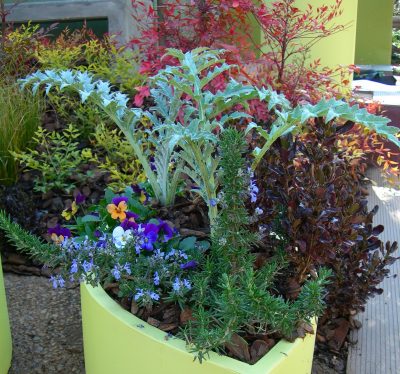
Edible perennial vegetables like artichokes, rhubarb, and asparagus have unusual or large leaves that work well as feature plants. They take up more space but also make more impact.
Globe artichokes are an obvious choice because of their spiky, silvery leaves and purple flowers. It’s a prized gourmet vegetable and is a fairly long lasting perennial. It needs sun, at least 1,2m space and well composted soil. Water well during summer. http://www.kirchhoffs.co.za/product/artichoke-green-globe/
Fancy foliage

You’d be surprised to find out how well cabbages and roses go together. They both like fertile soil, regular watering and plenty of sun. Plant cabbage as a border in front of the roses. The purple-blue leaves of red cabbage combine beautifully with marigolds. Curly Kale and Asian greens such as Giant Red Mustard, Mustard Red Frills, Mizuna and Tatsoi also offer colourful or unusually shaped foliage.
http://www.kirchhoffs.co.za/product/cabbage-baby-red-primero/
Vegetables with colourful stems, bright red, purple or silvery leaves are extremely ornamental. Red always shows up well, whether it’s the red and yellow stems of Swiss chard Bright Lights or the deep burgundy-red leaves of beetroot ‘Bulls Blood’. Beetroot likes loose soil that drains well, which also suits petunias, marigolds, nasturtium, and alyssum. http://www.kirchhoffs.co.za/product/beetroot-bulls-blood/
 Herbs are easy to integrate into the flower garden. They are a natural flavouring for food and most have insect repelling properties which benefits vegetables. Plant in groupings of three/ five or as a flowing line to make an impact. Those with striking foliage include lavender, rosemary, sage, sorel, salad burnet, celery and chives.
Herbs are easy to integrate into the flower garden. They are a natural flavouring for food and most have insect repelling properties which benefits vegetables. Plant in groupings of three/ five or as a flowing line to make an impact. Those with striking foliage include lavender, rosemary, sage, sorel, salad burnet, celery and chives.
http://www.kirchhoffs.co.za/product-category/herbs/
Growing tips
- Your mixed flower and vegetable plantings require more attention than a normal flower bed, in terms of watering and feeding. The extra effort will be richly rewarded.
- For a designer effect, work with focal points, texture, contrast, groupings and repetition.
- Vegetables are seasonal so there will be gaps as they are harvested. Either live with the gaps or have other seedlings or plants to take their place.
Text: Alice Coetzee



